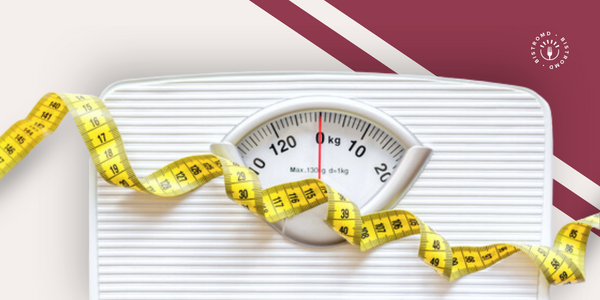
While dramatic weight loss may seem like the sexier option, losing weight too quickly can be dangerous. On the other hand, creating a calorie deficit to lose 2 pounds a week is a slower, more sustainable way to reach a healthy weight. Plus, it’s more likely to ensure you get all the necessary nutrients.
Keep reading for tips on how to lose 2 pounds a week.
What's Healthy Weight Loss?
Although the idea that weight loss requires more calories burned than calories eaten is correct, your actual weight loss journey may be more nuanced. Unless medically warranted, rapid weight loss isn’t recommended. In fact, losing weight too quickly can make it difficult to get the nutrients you need for your body to survive and thrive.
Instead of losing weight too quickly, research supports slow weight loss through sustainable habits. This method is more likely to create long-term change and can help you avoid regaining the weight lost.
So, how slow does weight loss need to be to reach your goal? It may sound surprising, but losing 1-2 pounds weekly is considered “healthy.” For example, if you’re looking to lose 10 pounds, a weight loss plan lasting 5-10 weeks would be appropriate.
Should You Lose 2 Pounds Per Week?
Now that you understand what healthy weight loss looks like, you may wonder, “Is losing two pounds per week right for me right now?” Weight loss goals aren’t universal. Instead, they are unique to each individual.
Whether or not you should lose weight depends on many factors. For example, weight loss may not be an appropriate choice if you’re recovering from an illness or injury or experiencing pregnancy. However, if your risk for heart disease is rising, weight loss may be a crucial part of your preventative treatment plan.
Deciding whether you should lose two pounds per week is a personal choice that your healthcare team can help you with. Generally, losing 1-2 pounds per week until you reach a healthy weight is considered safe for most people. Working with a dietitian and doctor can be valuable in identifying the risks and benefits of a weight loss plan.
How to Lose 2 Pounds Per Week
Weight loss doesn’t happen overnight but requires thoughtful daily habits. The following tips can inspire you to lose weight healthily by shedding a couple of pounds each week.
Revisit Your Diet
A daily caloric deficit is often needed to achieve the kind of weight loss you’re looking for. Generally, healthy weight loss starts by creating a calorie deficit of 500 calories daily. If a further deficit is needed, cut in intervals of 500 calories.
For example, if you’re consuming 2,500 calories currently, aim for a caloric intake of 2,000 calories a day. Then, work your way down to 1,500. Keep in mind that it’s difficult to get all the nutrients and energy you need as an adult if you’re eating less than 1,200 calories a day.
Remember, that the amount of calories you should burn may depend on factors like activity levels, health status, etc. Working with a dietitian can help provide you with individualized diet advice.
Remember Fiber, Protein, and Healthy Fat
Embarking on a weight loss journey doesn’t mean you have only to eat salads or drink green juice. Choosing nutrient-rich foods to complete your plate will keep you full and fueled.
Three nutrients that take longer to digest and can help curb cravings include fiber, lean protein, and healthy fats. This may initially sound overwhelming, but tending towards a plant-based diet can help you get more of these nutrients.
Try incorporating more of these foods as part of a plant-based eating plan for weight loss:
• Fruits and vegetables (with their outer layer or skin when possible)
• Legumes and pulses
• Nuts and seeds
• Whole grains
Reduce Portion Size & Pay Attention to Cues
One easy way to encourage weight loss is simply to reduce portion size. Serving food onto a smaller plate can help, and being aware of common serving sizes is also useful.
For example, 3 ounces is a typical serving size for meat, about the size of a deck of cards. Using portion control tips and tricks like this can help you dish out appropriate serving sizes, instead of filling up space on the plate.
Getting familiar with your own body cues can also be helpful. Often, your body will tell you when it’s hungry, thirsty, or full. Many people who practice listening to their body find that they are satisfied with smaller portions.
Ramp Up Your Exercise Routine
Exercise is another key part of any weight loss plan. However, with slow and steady weight loss, you’ll want to choose an exercise that excites you instead of forcing you to do a physical activity you hate.
Strength training, in particular, helps burn body fat while building muscle. Alternating strength training days with more moderate activities, like yoga or walking, can ease you into a healthy exercise plan. While aiming for 60-90 minutes a day is recommended, a short 15-20 minute walk or session can also make a difference.
Luckily, some non-exercise activities (commonly called NEAT) also count toward calories burned. This category of activities includes movement like typing, fidgeting, and standing. Making mindful decisions during the day, such as opting for a standing desk over sitting at your desk during work, can help you take advantage of NEAT for weight loss.
Losing 2 Pounds a Week: Final Bites
While it may seem slow, losing two pounds a week is considered the maximum rate for healthy weight loss. Luckily, losing little weight over a longer period is more likely to stick long-term. Small yet significant shifts in diet and exercise can help you make meaningful changes.






